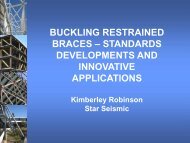Environmental Impacts of Multi-Storey Buildings Using Different ...
Environmental Impacts of Multi-Storey Buildings Using Different ...
Environmental Impacts of Multi-Storey Buildings Using Different ...
You also want an ePaper? Increase the reach of your titles
YUMPU automatically turns print PDFs into web optimized ePapers that Google loves.
- 51 -6 Life Cycle Assessment6.1 IntroductionThis section <strong>of</strong> the report investigates some <strong>of</strong> the environmental impacts <strong>of</strong> the fouralternative building designs through the use <strong>of</strong> Life Cycle Assessment (LCA).This work was carried out by Scion, a New Zealand Government Crown Research Institute(CRI).6.2 BackgroundLife Cycle Assessment (LCA) is the central theme <strong>of</strong> this research project. However, the LCAstudy is dependent on research and results obtained from other parts <strong>of</strong> the overall project,undertaken prior to the LCA. The necessary steps before being able to undertake the LCAstudy are summarised below;1. The design <strong>of</strong> four buildings – Concrete, Steel, Timber and TimberPlus.2. The quantification <strong>of</strong> the construction materials used in each building.3. Operational energy modelling and results for each design.Building on the above research, the LCA study compares the lifetime primary energyconsumption and the global warming potential (GWP) <strong>of</strong> the four buildings and investigatesthe environmental hotspots <strong>of</strong> each building.6.2.1 LCA OverviewLife Cycle Assessment is based on the concept <strong>of</strong> Life Cycle Thinking which integratesconsumption and production strategies over a whole life cycle, so preventing a piece-mealapproach to systems analysis. Life cycle approaches avoid problem-shifting from one lifecycle stage to another, from one geographic area to another, and from one environmentalmedium to another.Life Cycle Assessment is an analytical tool for the systematic evaluation <strong>of</strong> the environmentalimpacts <strong>of</strong> a product or service system through all stages <strong>of</strong> its life. It extends from extractionand processing <strong>of</strong> raw materials through to manufacture, delivery, use, and finally on to wastemanagement. This is <strong>of</strong>ten referred to as “cradle to grave”. A number <strong>of</strong> other environmentalassessment tools are restricted to the production process, which is sometimes called “gate togate”, or in the case <strong>of</strong> embodied energy covers the life cycle from “cradle to gate” withouttaking the end-<strong>of</strong>-life into account.6.2.2 Definition <strong>of</strong> LCAISO 14040 defines LCA as:“… a technique for assessing the environmental aspects and potential impacts associatedwith a product, by• compiling an inventory <strong>of</strong> relevant inputs and outputs <strong>of</strong> a product system;
















